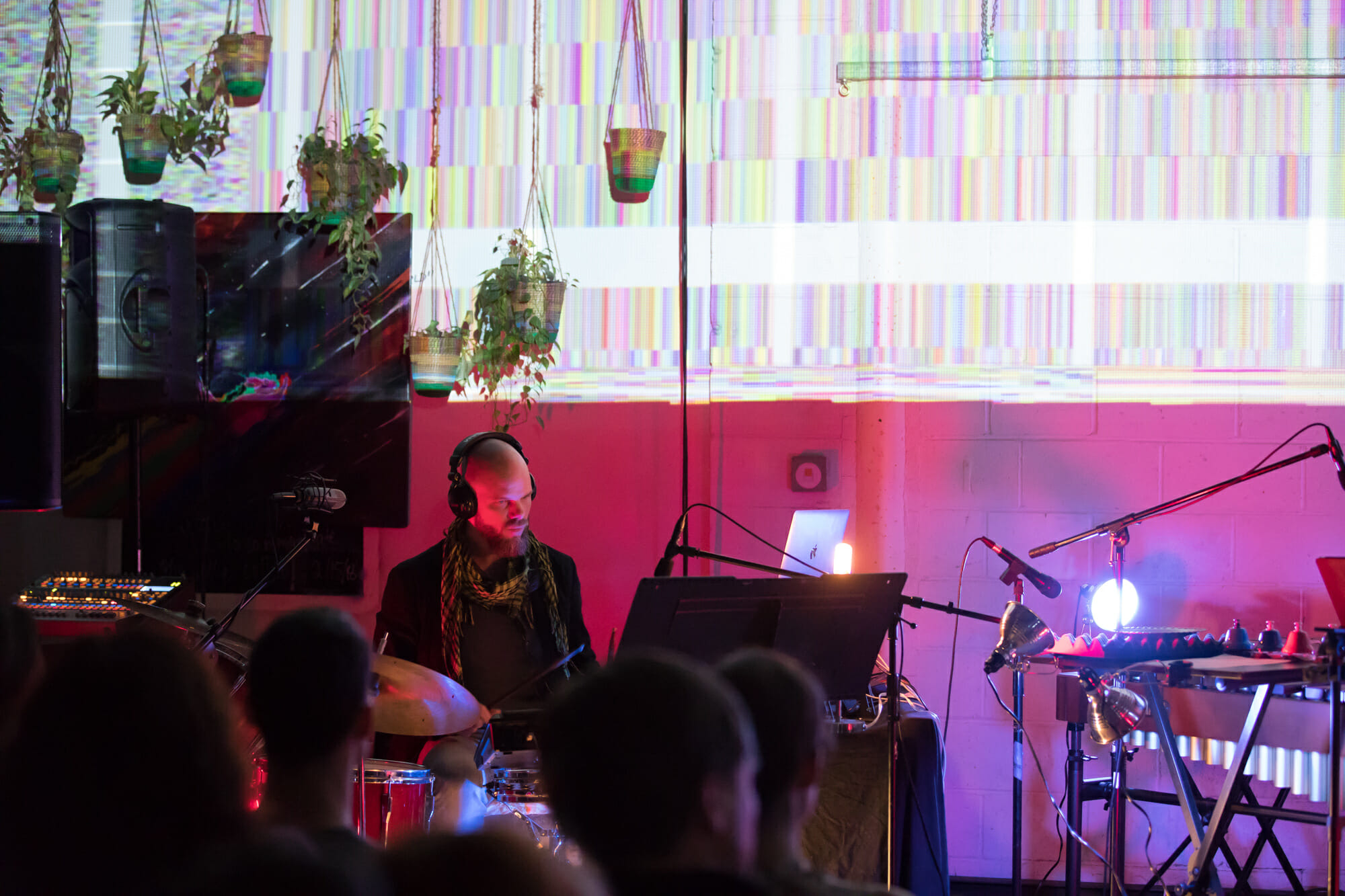Awakening Cities
Transforming the Built Environment with Sound & Light
Once known simply as “The Wall,” the Green Monster is Fenway Park’s legendary left field wall: one so tall, it’s wildly difficult to hit a ball over.
Images courtesy of MASARY Studios
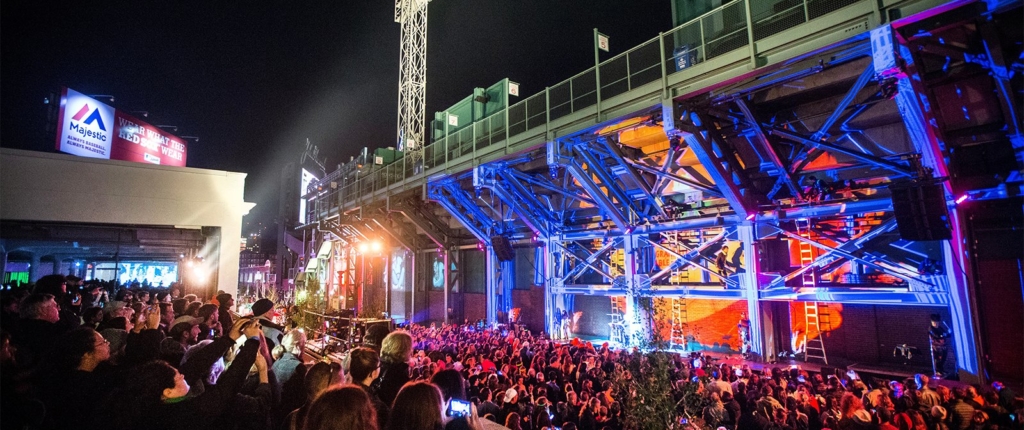
By Anastasya Partan
Imagine you’re near Fenway Park, Lansdowne Street on a summer night. As you approach the gigantic steel structure that supports the Green Monster, you hear a rhythm emanating from its bays. Not from a concert within the stadium, but from the actual wall. Then, you see that wall light up, and realize there are people in those bays, drumming on the beams like they’re instruments. A huge crowd is gathered under the night sky, looking up in amazement as images synced to the sounds are projected onto the Monster, bringing the legendary creature to life.
This performance was conceived and executed by MASARY Studios, a group of Boston-based artists. Using sight, sound, and the setting itself as instruments, the group awakens built and natural environments through immersive musical and visual experiences. From transforming the Green Monster into a musical giant to building interactive, light-up music cubes on Boston street corners, the trio is designing new ways to experience our favorite spaces and discover new ones – all while strengthening the fabric of the city.
MASARY Studios is Born
MASARY Studios (pronounced mah-SAH-ree) is made up of Maria Finkelmeier (MA), Sam “Samo” Okestrom-Lang (SA), and Ryan Edwards (RY). In 2014, percussionists Maria and Ryan collaborated on a musical project for the inaugural ILLUMINUS festival – a now annual nighttime event that invites Boston’s artists, designers, performers, and creative technologists to create imaginative audience experiences.
At the iconic SoWa Power Station in Boston’s South End, Maria and Ryan were set to play a custom-built set of wooden boxes and metal pipes, and ILLUMINUS’ Artistic Director Jeff Grantz positioned Samo so he was projecting onto Maria and Ryan – creating an instant, powerful connection among the artists and showing them the potential of what their combined, convention-defying musical and visual efforts could do to a space. “It was a very organic, intense moment,” says Maria. “The idea was: collaborate now, and make something happen spontaneously, with very little pre-production.” It worked. Soon after the show, Samo joined Ryan and Maria in their budding creative endeavor.
Waking the Monster
The ILLUMINUS festival was instrumental in MASARY’s creation, and it became an important launching pad for the trio the following year when the ILLUMINUS team asked MASARY to go bigger and make a creative playground on Lansdowne Street. In the fall of 2015, for the second ILLUMINUS festival, MASARY transformed Boston’s iconic Green Monster at Fenway Park into a three-story percussion instrument. If the task sounds unprecedented and monumental, it’s because it was. Fenway hosts countless musical performances – but its own structure has never been the musical performance. But, as Maria points out, if you can make music with LEGOs, pots, pans, boxes, and eggshells, why not a baseball stadium?
In many respects, MASARY’s audience-focused, space-aware approach runs parallel to design thinking methods, where empathy, ideation, prototyping, feedback, and response are essential to generating solutions with genuine, positive impact. To develop enriching and meaningful experiences, MASARY begins by asking: How can we create something that fulfills people’s emotional interests? And through that, how can we create new points of connection that have the potential to start a meaningful conversation or spawn new communities? The MASARY process has evolved from there.
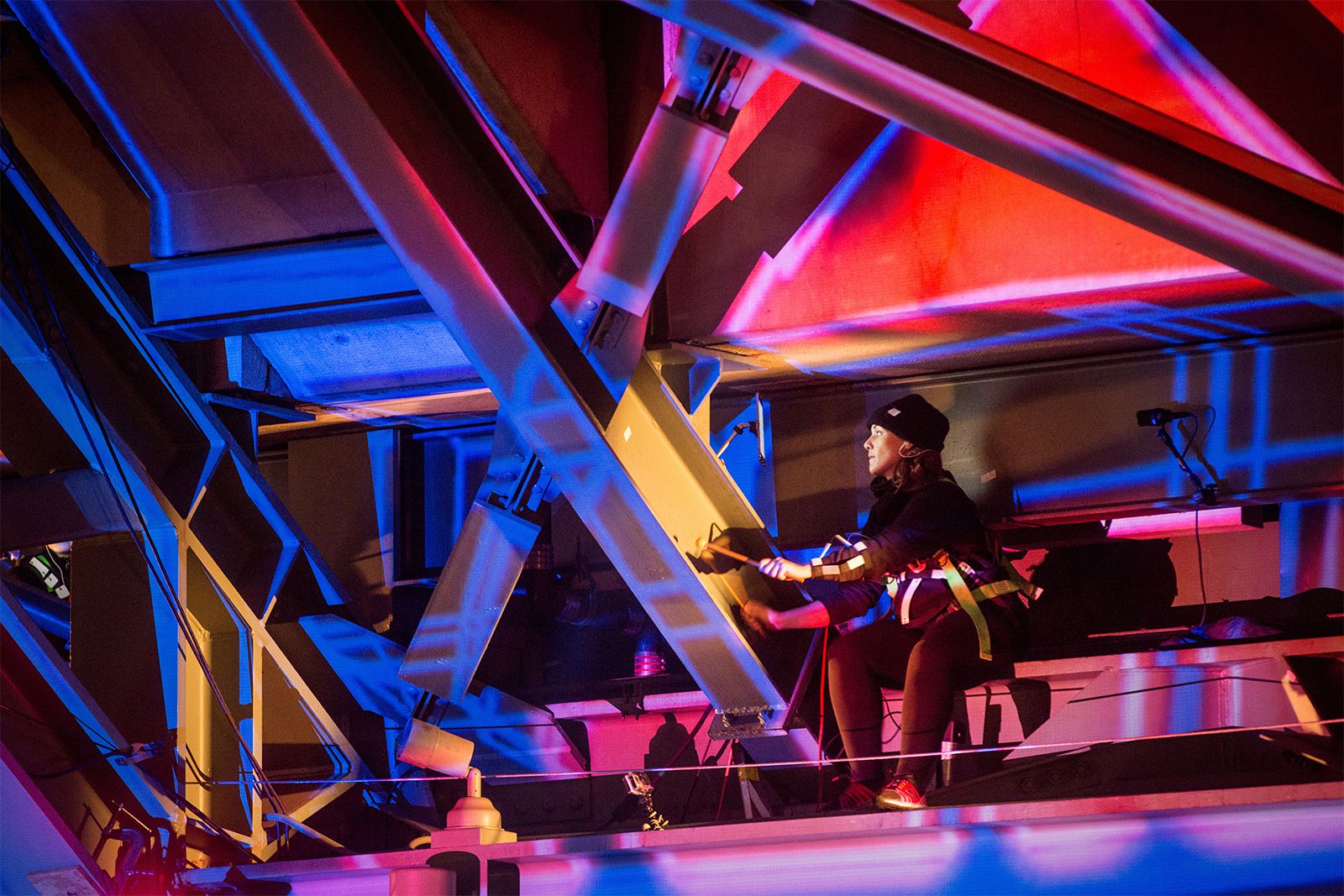
Maria Finkelmeier playing the steel girders behind Fenway’s Green Monster.
Learn the Space
With the site selected, MASARY enters into a kind of dialog with its past, present, and future. For Waking the Monster, MASARY first got intimate with the structure, climbing all over it – but also stepping back to see it from afar, as audiences would. Over the course of several weeks, they came back at various times and during ball games, when Red Sox Nation invigorates every inch of Fenway. “We were inspired by this urban, mostly manufactured myth of the Green Monster, and explored the legend of this creature coming to life, essentially waking it up so it can say all these things to the city. It’s an honest, strong, real and tough element of Boston that reflects the character of the city and its people, and we wanted to draw that out,” Ryan says.
“We’re artists, but with a creative, boundary-pushing inspiration and a deep interest in the user’s experience of what we offer,” he adds. “We think about spaces and the audience experience differently. This allows us to be more sensitive and attentive, as opposed to saying, ‘This is my piece – how can I present it?’ We’re working within certain parameters, which is exciting and keeps us grounded. It’s not just about our artistic integrity, but also about the integrity of the venue and the experience. That’s unique to the way we work.”
Customize Every Element
For the next step – the creation of the sonic palette – Maria and Ryan identified about fifty different locations on the Monster that produce varying sounds, which they and four other New England-based composers then used to write unique scores for the Green Monster. They placed eight drum triggers throughout the structure, while Samo worked on the second performative element: designing and creating animations that would respond to the different triggers and project back onto the structure. The theme, color scheme, and movement of the animation varied from piece to piece, working hand-in-hand with the music.
There is never a precedent for a MASARY event. “We build every project from the ground up,” says Maria, and MASARY’s fast-growing portfolio of interactive, experiential art, and design works around the city attests to this credo. This means that everything has to be figured out project by project. If the space they are transforming through sight, sound, and physical objects calls for a new creative solution, MASARY invests countless hours in learning the new technology or methods they believe will bring that environment to life and allow audiences to experience its full potential. There are no rules – and few creative constraints.
“We’re okay with being outside of traditional artistic programming, traditional places, and traditional presentation,” says Samo. “We’re not satisfied with any of the singular roads forward, and want to explore different models that engage with people in different ways. There is no ceiling to the process, the practice, and what we can achieve. That’s very influential and keeps us engaged.”
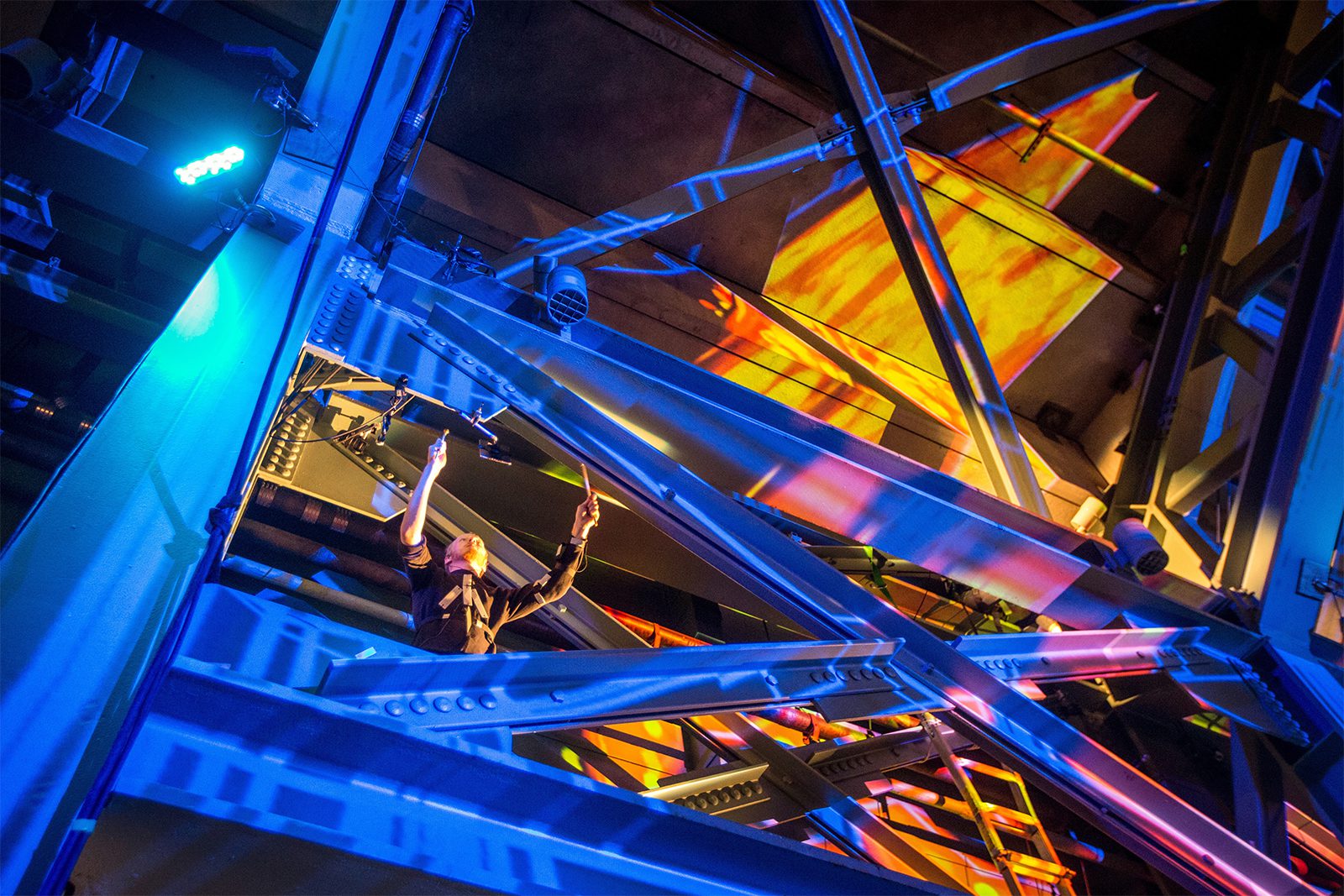
Team-Deliver
Collaboration is at the heart of the MASARY venture, and not just among the trio. The earliest blueprints for Waking the Monster included a plan for how the team can involve artists, designers, and other creatives in a collaborative process that yields the most fruitful results. The project drew in composers, lighting designers, stage builders, and other partners to bring the blueprints to life (not to mention a police detail to help the crowds navigate a transformed historic neighborhood).
Having rehearsed together first in a facility with metal chairs and instruments as mockups, and then on the Monster itself, nine percussionists – including Maria and Ryan – got into safety harnesses and made themselves at home in the various bays. As they played six new compositions, Samo projected images designed around the structure’s shape, color, and personality — activated by the drum beats. No audience member seems to have left the event untouched, describing the spectacle as “exciting,” “perfect,” “majestic,” and “a thrill.”
Urban Impact
Waking the Monster drew over 30,000 visitors to the festival on Lansdowne Street – a success by any measure. For MASARY, though, it wasn’t just about the numbers, but about the work’s ability to impact the people taking it in. This is, after all, the hallmark of great art and great design. “The best public art doesn’t just sit in a space, but interacts with the space and its surroundings,” says Maria. “We are always thinking about a story to tell.”
“Of course, we want people to have a great time and be immersed in what we’re doing,” adds Samo. “But if the conversation continues and gets people to reconsider their built environment or city or stories, then we have contributed and our work has a particular meaning. If people look at the space differently upon their next visit, then we’ve done our job.”
Gustavo Quiroga, the Director of Neighborhood Strategy and Development at Graffito SP, a real estate advisory firm focused on placemaking, urban design, and development, experienced the Green Monster’s transformation firsthand. “It was a remarkable experience to stand there with thousands of people at the girders of this structure that’s iconic to our city. But the iconic side is on the other side. For MASARY to play the utilitarian underbelly of that structure, to make it come alive in a way that gave it voice and personality, was fascinating. We are familiar with the noise of the ball hitting the bat and the yells and screams when a ball soars over the wall, but MASARY gave the Monster a new voice, spoken in a different language and a different pitch.”
“It’s not uncommon to play instruments and put visuals behind it – most good concerts will do that,” Quiroga continues. “But the added element of incorporating a medium that we think of as static into a piece of art and making it vibrate and reverberate – that was unlike anything I’ve experienced anywhere.”
Creative Impact
Delivering a stunning sensory experience is paramount to the group, but MASARY’s creative use of space also offers a solution to a logistical issue facing many cities, not least of all Boston. “It’s widely understood that we have a creative and performance space shortage,” says Quiroga. “What’s exciting about MASARY is that their work is not dependent on traditional performance space. They can go into almost any environment and put on a world-class performance. They thrive outside the walls of traditional performance spaces. If they can be an inspiration to other artists and help rethink how existing spaces can serve as performance spaces, I think that can be really powerful in meeting the demands for culture in the city.”
Carving one’s own path in a traditional city isn’t an endeavor without challenges – but MASARY’s founders share a love of uncharted territory. “We’re young, and the art form is really young,” says Samo. “In the last 10-15 years, large-scale video projection has created a new art form that’s constantly evolving – and our job is to keep opening new doors and creating the future of presentational, experiential fine art on a large, urban scale.”
Jason McCool, Head of Arts and Culture at the Aeronaut Brewing Company – a fast-growing cultural and community hub in Somerville, MA that recently hosted a MASARY event – views MASARY’s experiential, passionate approach as essential to the city’s future. “Boston is a very institutionally driven city. We are very fortunate to have so many legacy, long-standing institutions like the Boston Symphony, the Huntington Theater, the Handel and Haydn Society – with budgets in the multi-millions. And institutions are great – but they can’t always take the types of creative risks that new, emerging individuals can take, and I think people are looking for a change.”
“Maria and Ryan are world-class percussionists,” McCool, himself an Eastman School of Music graduate like Maria, points out. “They’ve played all over the world, and you could put them in any orchestra.” Yet they are committed to paving their own path, and, for a city working to resolve the tension between a historic past and a forward-thinking future, their constraint-free vision is invaluable.
“Boston has so much innovation and ambition, and to see that applied to the arts is thrilling,” McCool adds. “If artists want to be seen as an essential component of a modern society, particularly in a city that’s so smart and accomplished and ambitious, they have to be thinking just as much outside of the box as any business people are doing. In fact, artists should be leading that. People get inspiration from the arts. They are able to have their minds blown when they come to a MASARY show, and through that experience, they are able to get in touch with what it feels like to have possibilities.”
Lillian Sober Ain, a Newton, MA-based clinical psychologist and psychotherapist with an interest in the therapeutic use of rhythm, has attended numerous MASARY shows, and speaks to the connective power of their work. “It brings people together, as in theater, when you share an experience that helps you open up to the other human beings who are sitting around you, and can lead to amazing conversations. MASARY shares the narrative with us and draws us in. They make us feel part of the creative process, and that we as the audience are creating with them and watching it unfold in real time.”
When MASARY performed at Aeronaut, McCool recalls, “There was such a focus in the space, and you saw 150 people in abject silence, all just focused in on something. In our fast-paced society, you don’t often have that opportunity for people to get together as a community.” For MASARY, giving modern audiences this opportunity is always top-of-mind. “We’re all craving experiences beyond our phones,” says Maria. “Our aim is to create non-concertized opportunities for people to be in the same space and encounter art that allows reflection and personal experience.”
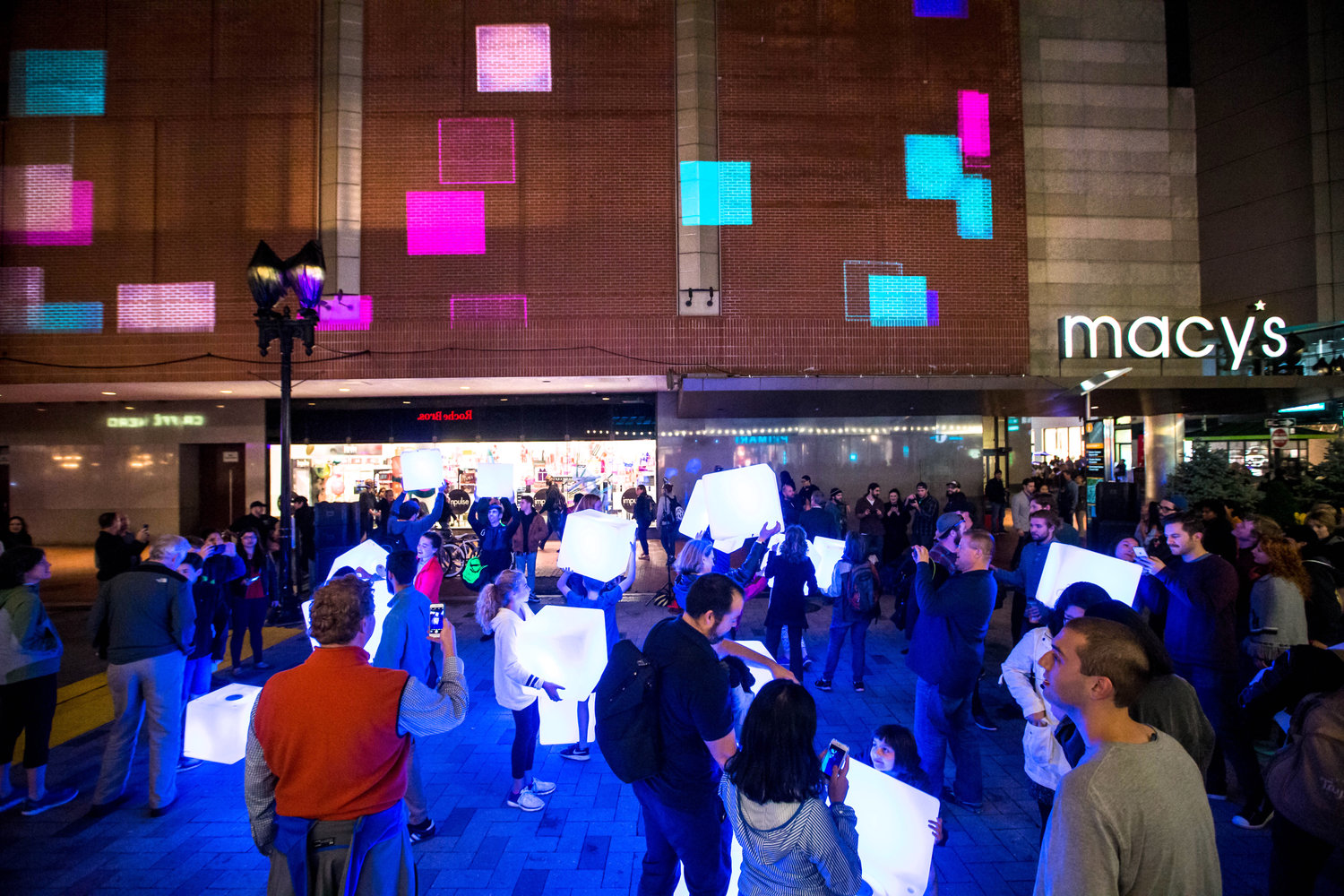
The Future of Urban Experience
Ultimately, the MASARY effect is just as much about awakening the built environment as it is about awakening its audiences to new ways of seeing and being. “One of our greatest hopes is to have a positive influence on the city’s youth,” Ryan says. “We hope they will see this kind of work and grow up with a picture of what other paths in life may look like. Imagine if you’re taken to as much of these experiences as to the ballet. You might look at your career options, civic space and life in general quite differently – and think differently about how to apply your passions.”
Making Boston synonymous with openness and innovation is essential to bringing this vision to life. “We hope to impact the future of the city, and help it regain and strengthen its leading, forward-thinking, tech-based, entrepreneurial identity,” Ryan adds. “We want people to think of Boston as a place that expanded their horizons and thinking.”
So long as MASARY continues to imagine the unprecedented, it appears Boston has a tireless ally in designing a thoughtful and relentlessly creative foundation for a connected, engaged community.
